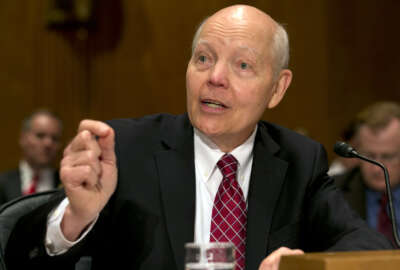
IRS looking to strengthen IT, customer service in fiscal 2017
IRS Commissioner John Koskinen pledged improved customer service, tougher enforcement and stronger cybersecurity for the agency as it looks for $11.8 billion in...
Armed with positive figures and proactive plans for the future, Internal Revenue Service Commissioner John Koskinen pledged to lawmakers that the money his agency is asking for this coming fiscal year will be put to good use.
Koskinen appeared Feb.11 before the House Appropriations Subcommittee on Financial Services and General Government, to talk about what the beleaguered agency plans to do with potentially $11.8 billion this upcoming fiscal year to improve customer service, strengthen its IT systems and toughen up on enforcement — as well as early changes it’s made thanks to an additional $290 million Congress gave to the agency for 2016.
“We’re hiring up to 1,000 new temporary and seasonal people,” Koskinen said. “We hire several thousand every year, 8,000 to 10,000 … it takes a little while to get them hired, but already the results are in. About 25 million returns have already been filed and the level of taxpayer service has already gone up.”
Koskinen said the goal for this upcoming filing season is to have a rate of 60 percent of taxpayers who reach an IRS employee on the phone within 2-5 minutes of calling. Right now that taxpayer service level is closer to 37-to-40 percent.
“It won’t be where we think it needs to be because the $290 million was out of a request for an additional $700 million in those three areas,” Koskinen said. “Part of the reason we have more requests for additional funding for taxpayer services in the 2017 budget is we think the level of service ought to be at 80 percent. … The 1,000 people, additional adjustments of resources will allow us we think to have taxpayer level of service in the low 60 percent. Our goal would be to try to get to 70, but if we had additional funding in ‘17, we could get to 80 percent.”
The IRS has requested $11.8 billion in the President’s fiscal 2017 budget, an increase of 4.7 percent over 2016 levels.
Koskinen said lawmakers could also help the IRS by passing a legislative package to improve tax administration. Among the proposals, he said, is renewing streamlined Critical Pay Authority, expanding the matching program for taxpayer identification numbers, granting the IRS authority to require minimum qualifications for paid tax preparers, and expanding electronic filing requirements for businesses.
Protecting personal information, preserving data
Rep. Ander Crenshaw (R-Fla.) wanted to know what steps the IRS was taking to address identity theft.
In 2013, GAO said about $5 billion was lost to fraudulent tax refunds. Koskinen told the subcommittee that number was down, but “it’s still a significant number.”
The figure has dropped in part due to better filters and improved detection capacity, Koskinen said.
“We hope that we finally begin to catch up with, if not get ahead of the criminals,” Koskinen said. “One of the ways we measure that is the percentage of suspicious returns and refunds we’re able to stop. We’ve already stopped 300,000 suspicious returns just in the front end of this, many of which we would not have been able to stop before.”
Koskinen also touched on a power outage last week at the IRS’ Martinsburg, West Virginia office as well as answered questions from Crenshaw about a former employee’s hard drive that was thought to be erased despite a court order to preserve the information on it.
Koskinen said the data was actually pulled off the drive, but what he’s decided to do is order the stop of any hard drive data wiping when an employee leaves the IRS. Instead, the data will be copied off the hard drive into an “electronic area” when an employee leaves. Koskinen said the hope is to have that practice in place for all employees leaving the IRS by the end of the year.
Koskinen said about nearly $20 million has been requested for a “modernized e-discovery” system that will be a database in which the IRS can pull “relevant documents and give them to you virtually overnight. In the meantime nobody’s wiping anything, we’re collecting data off of [hard drives] and saving it.”
Long-term impacts of funding cuts
Last year, the IRS collected about $3 trillion, which translates to about 93 percent of the money that funds government programs that everyone else supports, Koskinen said.
Rep. Jose Serrano (D-N.Y.) asked what the long-term impact of the cuts to the IRS are and how Koskinen plans to mitigate the damage.
Koskinen said leading into this year, the IRS is down 5,000 revenue agents, officers and criminal investigators, and that by the end of the year, that number will be 6,500. That means there are fewer people and thus fewer audits, which in turn cause taxpayers to think the IRS’ enforcement is “constrained, underfunded and no longer effective,” he said, and that risks undercutting the voluntary compliance system that is the platform for the IRS.
But Rep. Hal Rogers (R-Ky.) asked why taxpayer services were lagging while there was nothing that “explicitly reduces” funding for customer service, and in fact Congress increased customer service funding in fiscal 2014 and fiscal 2016.
“If service is so bad, as GAO says it is, and we’ve funded customer service, you say that you have had to use monies from all over to fund these other mandates,” Rogers said. “Our question is, the mandate we want you to have is to serve the public, and you’re not doing that according to GAO.”
Koskinen said at issue are the statutory mandates such as the Affordable Care Act and Foreign Account Tax Compliance Act with which the IRS is required to comply.
When Congress underfunds the IRS for those mandates “we have to find the funding somewhere else,” Koskinen said, pointing out that Congress has underfunded the IRS for the Affordable Care Act.
The priorities that are ultimately impacted are the same ones Congress and the IRS want to improve — customer service, IT and enforcement.
“The $900 million we did not get for information technology for funding the unfunded mandates had to come from other IT projects,” Koskinen said .”We do not replace and install every patch that we get. We get thousands of security patches and updates, they all take time, money and effort.”
While the $290 million is “a significant step forward,” Koskinen said, “we won’t be at the level we want it to be. The $290 million doesn’t fill all of the gaps that the $700 million in additional requests last year for those three areas would have done. But it will be noticeably different.”
Copyright © 2025 Federal News Network. All rights reserved. This website is not intended for users located within the European Economic Area.




